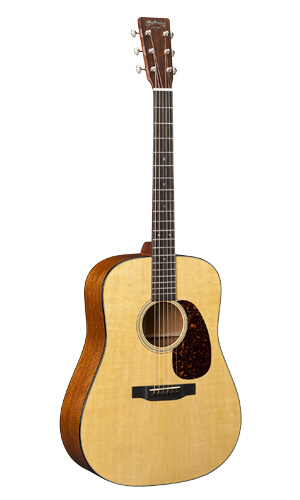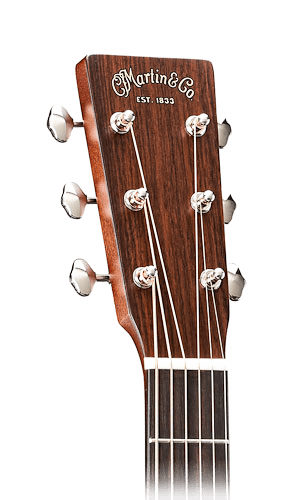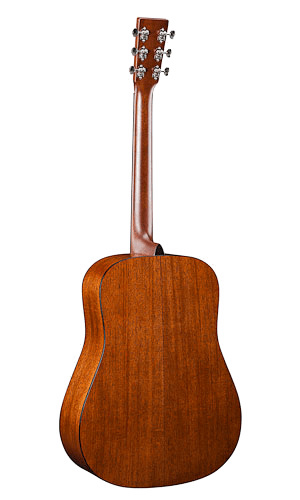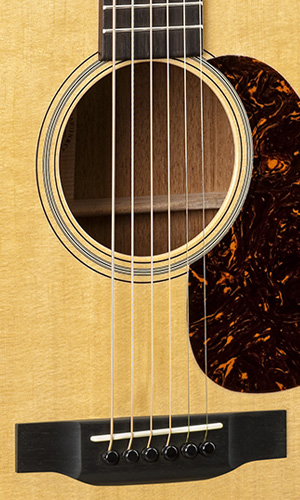Description
Martin D-18 Standard Series
It’s often said that “they don’t make ‘em like they used to,” especially when it comes to guitars, and for the most part, it’s true. Martin doesn’t make them like they used to. They make them way better. Incorporating modern production techniques with vintage details the D-18 features open-geared tuners, classic 18-style appointments, and a modern, low-profile neck for greater playability makes the transition to acoustic guitar easier for electric guitarists. In essence, an old soul in a new body, the Standard D-18 offers the warm tone of mahogany back and sides, coupled with the bright and defined attack of its Sitka spruce top and resonant scalloped bracing. An old-soul sound in a brand-new body, the D-18 dreadnought entered Martin’s lineup in 1939 and retains its understated elegant appearance and pure, rich tone.
Martin D-18—At a Glance:
Dreadnought body with 14-fret neck with ebony fretboard
Genuine mahogany back and sides, Sitka spruce top with gloss finish
High-performance neck taper
Precise fret dressing and optimal string action via Plek Pro process
Hand-made by skilled luthiers in the US
Optional Fishman or LR Baggs electronics
Hardshell case included
Martin D-18—Inside the Luthier’s Shop
Martin Innovations: dreadnought body and 14-fret neck
It light of today’s technological achievements in music, it may not sound very impressive that the dreadnought body style and 14 frets away from the body are such a big deal, but in 1916 the dreadnought was quite a big deal and remains the defacto body style for acoustic guitars.
Named for a class of World War I era British battleships The original Martin Dreadnought models were designed by Frank Martin and Harry Hunt, manager of Chas. H. Ditson Co., a leading music retailer. Having a finger on the pulse of the market, Hunt reasoned that a Dreadnought guitar, with its large body and booming bass, would be ideal for accompanying vocals. At first, the instruments were not very well received simply because there were not many singers using guitars, and solo players felt that the bass on the Dreadnought was overbearing. However, as folk singing became increasingly popular, sales of the Dreadnought picked up. Today, the Dreadnought is not only the preeminent body style for Martin, every acoustic guitar maker the world over offers a version of Martin’s Dreadnought.
14-fret neck, the industry-standard
Along with the Dreadnought body, C.F. Martin continues to innovate, introducing techniques and features that have become industry standards, including X-bracing and the 14-fret guitar (14 frets away from the body, 20 in total). According to C. F. Martin III, the 14-fret neck was developed in late 1929. Prior to the period, guitars were generally equipped with a 12-fret neck.
Perry Bechtel, a renowned banjoist of the day, suggested to Frank Henry Martin that he make a guitar with a 14-fret neck. Bechtel reasoned that the longer neck would increase the guitar’s range and make it a more versatile instrument. Following Bechtel’s advice, Martin introduced a guitar with a longer neck and dubbed it an “Orchestra Model.” The 14-fret neck was so well received that Martin eventually extended the feature to all models in its line. In short order, it became the standard design for the American guitar industry.
We’re not out of the woods yet
While electric guitars use various woods for tone, such as swamp ash or maple, but due to amplification and effects, the choice of wood is not as critical as acoustic guitars. Acoustics are where the specific characteristics of tonewoods come into play. The most common woods used for acoustic guitar are rosewood (Brazilian and Indian), mahogany, spruce, cedar, and maple. Mahogany is rich in the midrange, and perhaps the most versatile body wood when combined with other tops.
Sitka spruce is the most popular wood for acoustic guitar tops. Spruce is a lightwood with a very high degree of resonance—perfect for acoustic guitars. It’s found on all high-end acoustics, whether the body is made of mahogany or rosewood.
Ebony, being extremely dense, will provide a percussive attack and solid low-frequency response. It’s found on high-end guitars, since it’s far more expensive than rosewood.
Music Outlet Fun Fact: Brazilian rosewood is known for its visual beauty and rich overtones. However, descriptions of its tone can range from “helps to impart warmth and darkness” to “glass-like tap tone” to “almost metallic tone.” So which is true? Could it be that there are more factors influencing the sound of a guitar than just rosewood back and sides? The use of various woods in different parts of the guitar can direct its sound, but they cannot produce a definitive sound every time. There are some outspoken luthiers who no longer believe that Brazilian rosewood is the best tonewood out there, and that the scarcity of it is actually a ploy to drive up prices. In 1969, Martin switched production entirely to Rosewood, proving that great-sounding guitars can be made with less expensive woods.
Plek Pro fret and string optimization
A distinguishing characteristic of a Martin Guitar is playability and tone. Through the use of a Plek® machine, which is used in guitar production to perform precise fret dressing and optimal string action. No stranger to innovation, as we discussed above, Martin Guitar has adopted the Plek process to aid them in their mission to produce the best acoustic instruments.
The Plek Pro has been developed for use in guitar production factories as a tool that not only does precise fret dressing but also helps with quality control and R&D. This computer-controlled device scans and dresses a guitar under actual playing conditions; strung and tuned to pitch or using precise string tension simulation. The Plek Pro identifies precisely what needs to be done for perfect fretwork, executes this rapidly, and delivers perfect results on the instrument when strung.
About Martin Guitar and Strings
C.F. Martin & Co. has been creating the world’s finest acoustic guitars for 183 years. One of the world’s leading acoustic instrument makers, Martin guitars are hand-made by skilled craftsmen and women, who use a combination of new design and techniques, along with those introduced by the company founder.
The company is also known for producing high-quality, popular acoustic guitar strings, including the Martin SP LIFESPAN the fastest-growing treated string in the industry; Retro Strings line played and loved by Tony Rice and Laurence Juber; and the Martin SP line, which uses an industry-leading core wire to hold tuning.
Martin guitars and Martin strings are the instruments and strings of choice for musicians around the world, from the icons of rock, pop, country, folk, and bluegrass to those just beginning their careers.
If you’re ready to join the illustrious list of Martin guitar players, there’s no better place to start than with the guitar that spearheaded the acoustic singer-songwriter tradition, the Martin D-18. For more information contact or visit Music Outlet.
MARTIN D-18 SPECIFICATIONS:
Body Size: D-14 Fret
Finish Top: Gloss
Construction: Dovetail Neck Joint
Back & Side Finish: Gloss
Bracing Pattern: Forward-Shifted X-Brace
Scale Length: 25.4″
Brace Shape: Scalloped
Fingerboard Width At Nut: 1-3/4”
Top Material: Sitka Spruce
Neck Shape: Modified Low Oval
Back Material: Genuine Mahogany
Neck Taper: High-Performance Taper
Side Material: Genuine Mahogany
Electronics: Optional
Electronics Options:
• Fishman Gold Plus Natural I
• Fishman Infinity Matrix
• Fishman Presys Plus
• Fishman Ellipse Matrix Blend
• LR Baggs Anthem
TOP
Top Color: Aging Toner
Bridge Style:
Modern Belly – Drop In Saddle
Binding: Faux Tortoise
Bridge String Spacing: 2-5/32″
Top Inlay Material: Multi-Stripe
Bridge Material: Ebony
Top Detail: N/A
Bridge Pin Material: Black Plastic
Pickguard: Tortoise Pattern
Bridge Pin Dots: N/A
Pickguard Inlay: N/A
Saddle: Compensated Bone
Rosette: Old-Style 18 Multi-Stripe
Saddle Radius: 16″
BODY
Brace Material: Sitka Spruce
Back & Sides Color: Dark Mahogany
Brace Size: 5/16″
Back Detail: N/A
Back Purfling/Strip: Style 18
Back Inlay Material: N/A
Heelcap: Faux Tortoise
Side Detail: N/A
Endpiece: Faux Tortoise
Side Inlay Material: N/A
Endpiece Inlay: N/A
NECK
Neck Material: Select Hardwood
Fingerboard Material: Ebony
Neck Finish: Satin
Fingerboard Width At 12th Fret: 2-1/8”
Neck Color: Dark Mahogany
Fingerboard Inlay Style: Old-Style 18
Number Of Frets Total: 20
Fingerboard Inlay Material: Abalone
Neck Joins Body At: 14th Fret
Fingerboard Binding Material: N/A
Side Dots: White
HEADSTOCK
Headstock Shape: Solid With Square Taper
Tuning Machines: Nickel Open Gear
Headplate Material: East Indian Rosewood
Knob: Butterbean
Headplate Logo Style:Script Old-Style Overlay
Nut Material:Bone
Headplate Binding Material: N/A
MISC
Case: Ply Hardshell
Left Handed Availability: Yes
Label: N/A
Pleked: Yes





